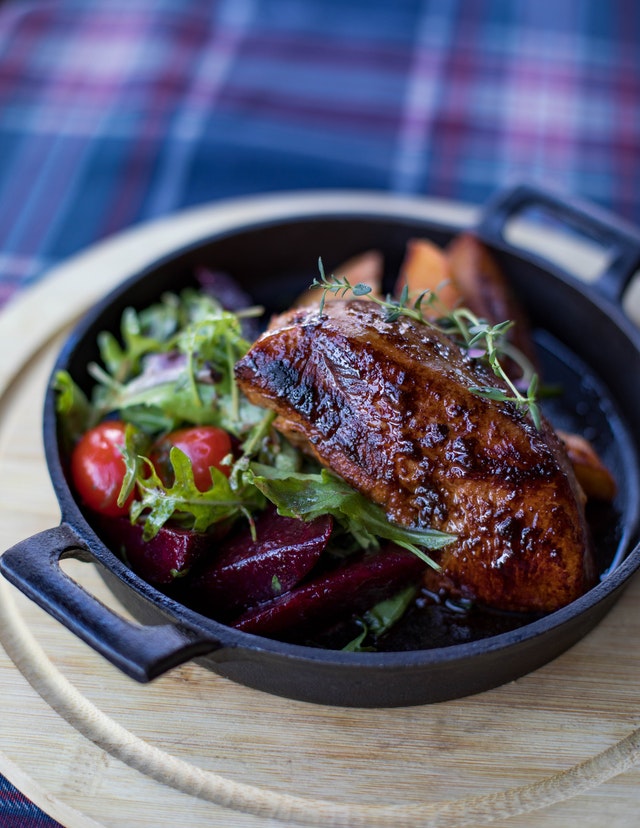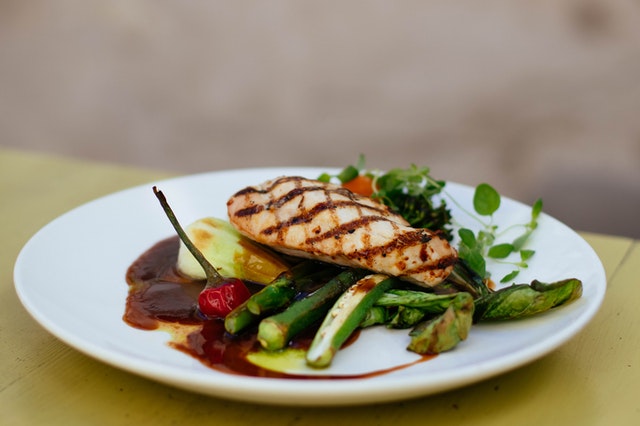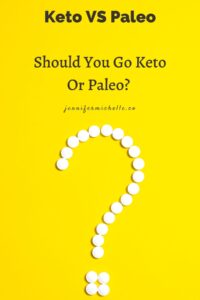I earn a small commission via affilate links at no extra cost to you.
When weighing keto -vs- paleo, it’s important to understand the difference because although they are similar they are quite different. A well-balanced keto diet is always paleo but a paleo diet isn’t necessarily keto. What is a keto diet and how does it differ from the paleo diet? The amount of carbohydrates you consume is primarily what separates the two. Most people living in the modern world have spent years consuming a carbohydrate-rich diet. If you’re like me you grew up with grains as the base of the food guide pyramid. Although our Paleolithic ancestors followed keto and paleo diets, in today’s world they are nearly a 180-degree turn from a grain-based diet. Your ultimate goal should be metabolic flexibility. That is, your body should be able to use any fuel that you feed it. In the primal health community, many of us do a dance between keto -vs- paleo. The ketogenic state is a natural state but we also don’t advocate doing math at every meal and obsessing over numbers. For decades we’ve been told to avoid dietary fat so it’s reasonable to wonder if the paleo or keto diets are healthy.
Should You Go Keto Or Paleo?
Your current set of health circumstances determines whether you should start with paleo or keto. You see, when your body is used to a carbohydrate-heavy diet your body learns to prefer carbohydrates as its primary fuel source. Making an immediate jump to the paleo diet will give most people a pretty significant carb flu. Jumping straight into keto will only make it worse because you’re removing even more carbohydrates all at once. Whether you adopt a keto or paleo diet immediately really depends on how much of a carb flu you’re willing to tolerate.
What is a keto diet flu? It isn’t the actual flu, rather you’d be asking your body to immediately switch to fats and protein for energy. Your body has to build the metabolic machinery, remember how to use those fuel sources well before it gets good at using them. While your body is ramping up these cellular processes most people experience headaches, fatigue, joint pain, moodiness, and of course digestive changes. They will go away but it’s something to be aware of when weighing your keto -vs- paleo options.
Most of the primal health coaches I know began their journey with the primal blueprint diet. Over time many of us have naturally gravitated to a low carb keto diet. When your body remembers how to access stored body fat for fuel you’ll find that the keto diet is easy to follow. You’ll also find that you’re no longer hungry all day like you used to be. In order to make up the calories, your diet gets filled with fat. A ketogenic diet is roughly 70% fat depending on the person. If you’re not eating many carbohydrates and there is an upper limit to protein intake, fat is the only other macronutrient you can fill your diet with.
What’s The Difference Between Paleo, Keto, and Primal?
Paleo is also known as the Ancestral Diet; that is, what did our ancient Paleolithic ancestors eat? Imagine yourself out in nature far away from the modern world. If you had to live there what would you eat? You’d eat what you could forage and hunt, a.k.a. the original human diet before we “modernized” it with agriculture. Your real food diet would consist of plants, nuts, seeds, eggs, fish, fowl, meat, and seasonal fruit.
Benefits of the paleo diet
- Removes many foods that cause sensitivities
- Burns off stored fat
- Stabilizes blood sugar
- Gives the body space to detoxify
- Improves sleep patterns
- Increased nutrient density from whole foods
Primal is almost exactly the same as paleo except that it allows for dairy whereas a strict paleo diet does not. The thinking behind dairy in the Primal world: If you have Paleolithic ancestors from the higher latitudes (near the poles) there is a very short growing season for plant life. It is thought that in order to survive these Paleolithic ancestors would have relied on milk to help get through the lean times. Consequently, those who could consume this food source had a better chance for survival and passed their genes to the next generation. On the flip side, those who have Paleolithic ancestors from the equatorial region of the planet had access to plant life year-round. They didn’t have to rely on dairy and today most of the people who are lactose intolerant have genetics that comes from this region. Whether or not your body tolerates dairy really depends on your genetic inheritance more than anything else.
The keto diet is very low in carbohydrates but it’s also perfectly safe and healthy for most people. You might wonder how plants, nuts, seeds, eggs, fish, fowl, meat, and seasonal fruit would need changing to fit the keto diet. What changes are needed for a keto diet? If you want to go keto you have to watch the carbohydrate intake found in root vegetables, fruit, and even nuts and seeds. The general rule of thumb is meat, and plants that grow above the ground, are the basis of a well-balanced keto diet. Whether or not you include dairy really depends on you. People who pursue the keto diet for weight loss often find that dairy hinders their ability to lose weight. Think about it, dairy is food fit for growing an infant, and if you’re not looking to grow it’s likely best kept to a minimum.

How Low-Carb Can You Go?
When you’re weighing your keto vs paleo options the major differences are carbohydrate intake, dairy, and whether you follow clean or dirty keto. The goal behind the keto diet is to reach a metabolic state known as ketosis. In ketosis, your body will rely on stored body fat for energy. Our Paleolithic ancestors were hunter-gatherers who ate a high fat, moderate protein, and a low carbohydrate diet. When the body relies on fat as an energy source, instead of a steady stream of glucose, most people feel better than they ever have and they find weight loss incredibly easy for the first time in their life. Conversely, when glucose is always available the body burns the glucose first. Your body stores glucose in liver and muscle cells. When those are full the excess glucose has nowhere to go and the body begins storing it as body fat.
Is Keto Safe?
We’re all born into a ketogenic state and it’s how our Paleolithic ancestors survived before we invented modern agriculture. Fat provides 9 calories per gram whereas carbohydrates and protein only provide 4 calories per gram. Our Paleolithic ancestors were fat hunters. When a person’s diet is full of lean protein without many carbohydrates or fat something called rabbit starvation sets in. A diet that has too much protein without enough fat can result in death after several weeks.

Answering the question is keto safe it’s easy to look around and see what our low fat, whole grain guidelines have produced. Only 12% of Americans are currently metabolically healthy. A person who eats a high carbohydrate diet for a number of years is at high risk for developing type 2 diabetes. When you have type 2 diabetes you’re at higher risk for: heart disease, liver disease, kidney disease, neuropathy, Alzheimer’s, dementia, glaucoma, and cancer.
One of the most popular negative arguments you’ll hear about the keto diet centers around ketoacidosis. It’s true that ketoacidosis isn’t a good thing. The keto diet is healthy if you’re not at risk for developing ketoacidosis. Ketoacidosis happens when you have high blood sugar and high ketones. This is one of many reasons why I dislike the ketones you can buy. If you don’t know what you’re doing you’ve likely heard that drinking this ketone beverage will help you lose weight, and then you turn around and have pizza for lunch. You’re combining ketones and carbohydrates and hopefully, your body can manage the carbohydrates. Don’t take exogenous ketones if you have diabetes. Ketoacidosis may ultimately result in coma and death. [1]
Is Keto Healthy?
When you’re in a ketogenic state your body produces ketones as a fuel source. We know that carbohydrates, fats, and protein are the primary macronutrients, ketones present a fourth macronutrient. When the body breaks down fat it makes the ketones beta-hydroxybutyrate (B-OHB) and acetoacetate which are utilized a as fuel by most organs and cells in the body.
Potential Benefits of the Keto Diet [2]
- Weight loss
- Fat loss while retaining lean muscle mass
- Reduced hunger cravings
- Enhanced exercise recovery
- Increased focus, concentration, and energy throughout the day
- Raising HDL “good” cholesterol and increasing LDL “bad” particle size, both associated with decreasing the risk of heart disease
- Decreased free-radical production
- Neuroprotection
- Proven medical uses include: treating drug-resistant epilepsy
- Current research is investigating the ketogenic diet in relation to managing: metabolic syndrome, type-II diabetes, cancer, Alzheimer’s disease, Parkinson’s Disease, and sleep disorders
Asking the question is keto healthy, from the list above I hope it inspires you to do more research. For me personally, I genuinely feel better the fewer carbohydrates I eat. Other friends in the primal health community have said the same thing. I’ve followed an ancestral health approach since 2016 and I’m a firm believer that most people simply do not know how much better they could feel. I’ll turn 47 this year and I feel better than I did in my 20’s. Heck, my friend Al was given 3 months to live after his cancer diagnosis in 2018. After adopting a keto and then carnivore diet he’s now cancer free.
How Does A Keto Diet Meal Compare To A Paleo Diet Meal?
The carbohydrate content of a paleo meal can vary. Some paleo meals can fit the keto diet macros whereas others won’t. Paleo focuses on eating foods with fat and protein but doesn’t necessarily avoid potatoes, carrots, sweet potatoes, and other foods high in carbohydrates. A meal in the paleo diet can contain a lot of fat, making it keto, but it doesn’t have to be. The elimination of grains and beans on a paleo diet will naturally make it lower in carbohydrates than traditional diets. However, this doesn’t mean that you should buy every packaged food you find with paleo written across the front. There are now a lot of pre-packaged paleo foods that can contain a lot of carbohydrates. It is possible to eat as many carbohydrates as you’d find in a conventional diet if you don’t pay attention.
What is a keto diet in relation to the paleo diet? Keto has a sharper focus on the number of carbohydrates and fat that are eaten at each meal, and during the day. While the paleo diet doesn’t put a restriction on root vegetables or fruit, the keto diet eliminates all starches and sugars, including fruit. Our Paleolithic ancestors didn’t have access to fruit year-round. This is one of the many reasons a true keto diet is healthy, people aren’t eating an overabundance of fruit all year long. Most of the carbs on a healthy keto diet come from non-starchy vegetables, think vegetables that grow above the ground. Keto diets are high in healthy fats. Dietary fat is the primary element of a low-carb diet as it supports ketosis, the metabolic process of burning fat for energy versus dietary carbs.
Another difference between the paleo and keto diets is dairy. A quick scroll for keto recipes on Pinterest you’ll find a lot of dairy-filled recipes. Paleo on the other hand eliminates dairy because the casein protein affects the gut the same way gluten does. If you’re struggling with autoimmunity, food sensitivities, skin issues, digestive issues, and countless other issues you may also want to avoid dairy on your keto diet. After all, one of the reasons you are going keto is to get healthy. Right?

Originally posted on March 19, 2021 @ 09:39





